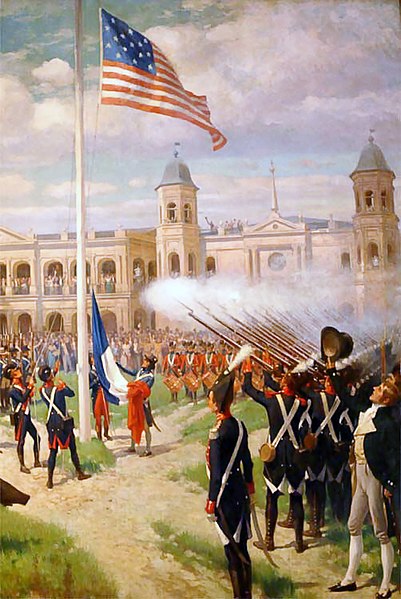The Louisiana Purchase (French: Vente de la Louisiane "Sale of Louisiana") was the acquisition by the United States of America in 1803 of 828,000 square miles (2,140,000 km2) of France's claim to the territory of Louisiana. The U.S. paid 50 million francs ($11,250,000) plus cancellation of debts worth 18 million francs ($3,750,000), for a total sum of 15 million dollars (less than 3 cents per acre) for the Louisiana territory ($234 million in 2012 dollars, less than 42 cents per acre).
Treaty signing
On Saturday, April 30, 1803, the Louisiana Purchase Treaty was signed by Robert Livingston, James Monroe, and Barbé Marbois in Paris. Jefferson announced the treaty to the American people on July 4. After the signing of the Louisiana Purchase agreement in 1803, Livingston made this famous statement, "We have lived long, but this is the noblest work of our whole lives...From this day the United States take their place among the powers of the first rank."
The United States Senate ratified the treaty with a vote of twenty-four to seven on October 20. The Senators who voted against the treaty were: Simeon Olcott and William Plumer of New Hampshire, William Wells and Samuel White of Delaware, James Hillhouse and Uriah Tracy of Connecticut, and Timothy Pickering of Massachusetts. On the following day, the Senate authorized President Jefferson to take possession of the territory and establish a temporary military government. In legislation enacted on October 31, Congress made temporary provisions for local civil government to continue as it had under French and Spanish rule and authorized the President to use military forces to maintain order. Plans were also set forth for several missions to explore and chart the territory, the most famous being the Lewis and Clark Expedition.
France turned New Orleans over on December 20, 1803 at The Cabildo. On March 10, 1804, a formal ceremony was conducted in St. Louis to transfer ownership of the territory from France to the United States.
Effective on October 1, 1804, the purchased territory was organized into the Territory of Orleans (most of which became the state of Louisiana) and the District of Louisiana, which was temporarily under the control of the governor and judges of the Indiana Territory.




